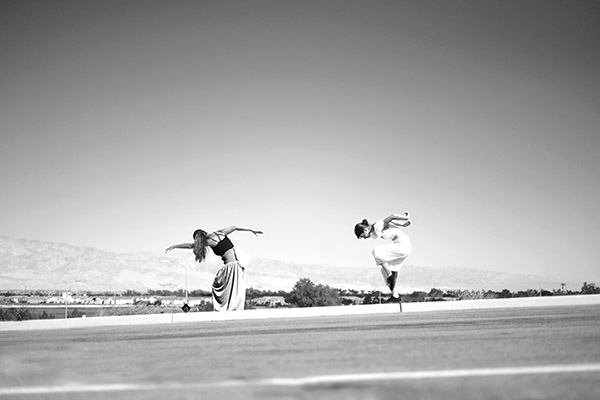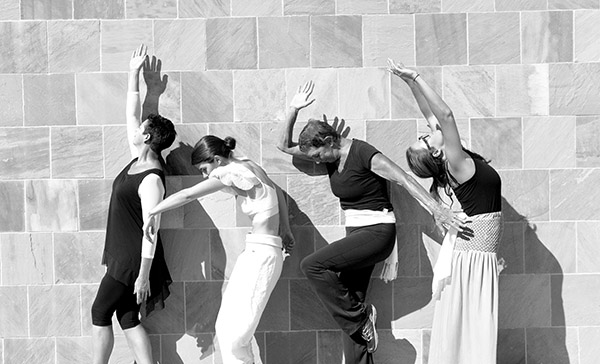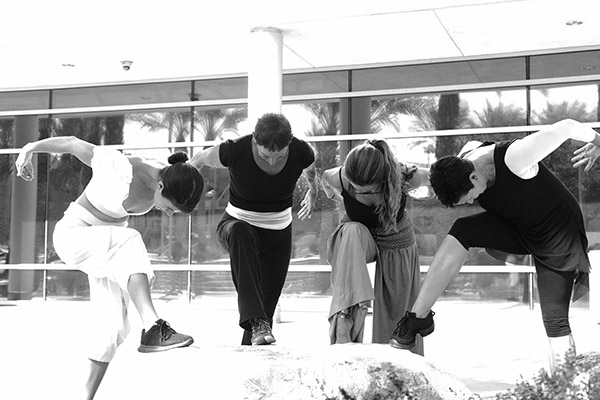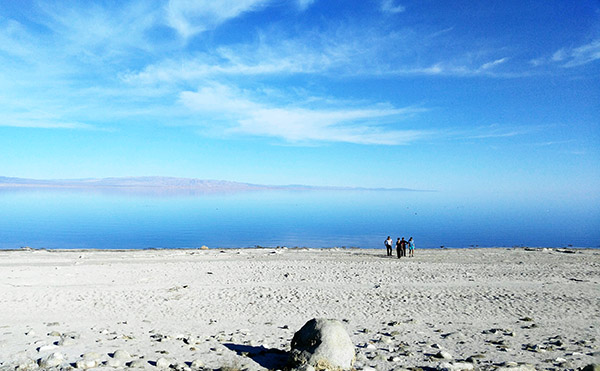A Flourishing Resilient Community
Desert Movement Arts, based in California’s Coachella Valley, is a collective rooted in improvisation, collaboration, ritual, explorations, collages and choreography. Its practices are inspired by the desert environment, postmodern dance, activist art, queer and feminist explorations, contact improvisation and site-specific choreography. Brittany Delany and Constance Clare-Newman, two of its four members, share an in-depth view of their work and the cultural landscape.
This interview is part of Where Dance Is, a series of interviews with dance artists working outside major metropolitan centers.
Photo by Monica Morones
~~
Where do you live and work, and how did you come to be based there?
Constance: I live in Palm Springs most of the year, but I spend summer months in Provincetown, Cape Cod, MA. After moving to Provincetown from the Bay Area in 2015, my partner and I came running back to California for sun and warmth. We are certainly getting that in the desert! Going between these two gorgeous and very different places is of course a luxury, yet is it also challenging in maintaining community and consistent dance practices.
Brittany: I live in Indian Wells, and I moved here a few years ago to begin working for arts and culture organizations like La Quinta Arts Foundation and California Desert Arts Council. Prior to living in Greater Palm Springs, I lived in Canelo, AZ, Santa Fe, NM, and the Bay Area.
Can you describe your current dance and teaching practice?
Constance: At 56, I am once again in transition, this time to fewer technique classes and more movement exploration. I am interested in un-doing aspects of the forms I spent a lifetime building, and finding what is less habitual, less domesticated. As an Alexander Technique teacher, I do have a head start in un-doing patterns! Yet as I play with ways of moving that are atypical for me, I find that moving into pleasurable sensations is of more importance than external form. Un-domesticating and un-forming as somatic practice feels supportive and nurturing at this stage of life.
All that said, I also teach an adult ballet class twice a week! Mostly because this is the dance class that most people want. As I subvert the dominant paradigm of ballet by inviting more pleasure into classes, I hope to both educate more gently and inspire a kinder way of being in an adult body. I also give Mindful Movement classes for dancers and non-dancers, in which we attend to somatic awareness, explore intuitive or expressive movement, and give permission to let go of cultural norms of “dance.”
Brittany: My current dance and teaching practice consists of co-leading the movement improvisation collective Peer Practice in the Desert with Constance Clare-Newman (Palm Springs) and Sue Roginski (Riverside). Every first Sunday at a rotating location in the desert region, we explore a theme, site and improvisational movement score. Admission is free, and we always say, “Free to participate. Participate with freedom.” This practice is where I experiment with teaching: styles, questions, group vs. solo/duet/trio direction, and where I learn from the collective of teachers who take turns leading among the group. Some of my favorite ways of moving involve my training in improvisational techniques – freestyle hip hop dance upright styles, ensemble postmodern dance, and contact improvisation training. These techniques sometimes become part of this practice, and I love the opportunity to re-orient myself each time we set up for Peer Practice. (To learn more, visit www.facebook.com/peerpracticedesert)
In addition, I practice in the studio at my gym, in public parks, and at social dance spaces where I can get down to a variety of music, including live musicians, DJs or special guest performers. While I do miss the opportunity to take technique classes, I opt to give myself class in certain trainings and modalities that I’ve learned from my teachers over the years. Occasionally, I sign up for a movement class or workshop out of town on the weekend to get back into that discipline, rhythm and exchange of information.
I am currently developing a duet entitled ‘task’ with my colleague Sarah Ashkin, co-director of our collective GROUND SERIES. We will perform the piece at Highways Performance Space in Los Angeles on August 17 and 18, 2018. Dealing with themes of failure, listening and accountability, this duet asks: What is the task of white women in our current political moment? ‘task’ is a public practice reflecting on the problematics of the white female body moving through the foreground and background. GROUND SERIES is a dance collective using performance as embodied political intervention. Each GROUND SERIES production is rooted in ensemble collaboration, interdisciplinary approach, inquiry-based content, and site-specific dance-making. In practice and performance, dance is used as a means of personal and communal transformation and as a catalyst for community dialogue. Since its inception in 2012, GROUND SERIES has created 15 original dance works performed throughout the San Francisco Bay Area, Philadelphia, northern New Mexico, and London.
How would you describe the general dance scene where you live?
Constance: The Coachella valley has plenty of neighborhood dance studios that specialize in competition dance. Dance as an art form is rare and, if there is any post modern or experimental dance and movement, I have not found it… Until we started Desert Movement Arts!
Photo by Monica Morones
Brittany: Some of my vivid memories from the dance scene in the Coachella Valley include unique experiences across this region:
-Witnessing dancers from Rancho Mirage High School rehearse their athletic, syncopated dances to high energy hip hop music on the basketball court at the public park, while I was nearby on the grass, practicing a solo piece ‘Light the Way’ for the SF Movement Arts Festival 2017.
-Simeon Den performing a riveting solo outside his gallery in Cathedral City. He performed modern dance in front of a video projection on a wall, which was covered with large translucent paper, featuring charcoal tracings of black crows. The wind fluttered the paper birds, the sound from the video and the sound of his breath filled the outdoor space. He has a magnetic stage presence.
In 2018, Simeon welcomed Wyld Womxn (a Coachella Valley-based feminist art collective of which I am a co-leader) to program a performance night, including works by Desert Movement Arts members Constance Clare-Newman, Lauren Bright and me. We were thrilled by the large audience turnout and supported by the local media for our event – which was part of the gallery art exhibition ‘The New Feminist Gaze.’
-Viewing complex choreographies and ritual performances by Danza Azteca Citlaltonac, first at a community event ‘Synergy Fest,’ featuring music, arts, spoken word and a classic car show. It was presented by Culturas Music & Arts at Dateland Park, featuring the historic Shady Lane Mural. Nearby is the internationally recognized Coachella Walls.
Secondly, I gathered at Sunnylands for a special Dia de los Muertos event which welcomed community organizations to contribute altars, participate in crafts, walk in the gardens, and celebrate the live performance by Danza Azteca Citlaltonac. This time, their performance took place at the center of the manicured estate, under the stars, with a hushed, engaged crowd. This showing really made an impact on me – the detail, the up-close view of the costumes, the commitment and risk of the dancers’ movements and unexpected changes of direction. The spiritually grounded experience reminded me of my university research trip to the Dominican Republic with Wesleyan dance professor Pedro Alejandro, who introduced me to his ethnographic research in sacred arts practices, dance history and cultural practices.
-At a performance ‘East Valley Out Loud’ 2017 at the McCallum Theatre, I witnessed an amazing showcase of talented performers. The dancers of the Purepecha community of Mecca (Purepecha is an indigenous group from the Mexican state of Michoacan; many live in the Eastern Coachella Valley) blew me away with their intricate footwork and travel patterns.
What do you perceive are the benefits and drawbacks to working where you live?
Constance: The benefits are that, as Desert Movement Arts grows, we could become a resource for other experimental movers. Since we do not see other companies making intergenerational and experimental work, we are free to create with less preconceived ideas. Another benefit that we experienced after our first performance last year is that many in our audience hadn’t seen a dance performance like ours and were excited about what they saw. The drawbacks are mostly that no one knows what we are doing! So our future includes educating our audience, as well as inviting a coterie of movement arts lovers.
Photo by Monica Morones
Brittany: Benefits to working where I live:
-Space. The desert is vast, and dance loves to be in space!
-Visual artists and musicians love the desert. Dance loves visuals and music!
-So many visual artists make the desert their home, there is an abundance of galleries, exhibitions, installations, public art projects and photographers all milling about in this region. It makes for a vibrant resonance around ‘image-making’ when I consider dance-making here. I’m lucky to work for La Quinta Arts Foundation, presenter of the number one fine arts festival in the nation, La Quinta Arts Festival, which presents top contemporary exhibitors in over a dozen mediums. I’ve met numerous artists who exhibit in the annual event, and their dedication to their artwork and business has filled me with so much respect and admiration for fine artists.
-Musicians and DJs flock to the desert too. I enjoy going to music concerts and events where DJs keep the dance floors full for everybody to enjoy.
-There are so many talented drag queens and kings innovating here, and the community embraces and supports drag shows every night of the week. Viewing drag performance reminds me of the power of transformation and that perfect biting, edgy sense of humor. For more info, check out Toucan’s in Palm Springs and follow Bella Da Ball. Big gratitude to CounterPulse in San Francisco for opening my eyes to the art of drag performance and to the complex histories of performance art.
Drawbacks:
The desert is not a dance-hub, filled with a million dancers who come from all over the world to view, make, re-design, present, socialize, compete, construct, laugh, eat while dancing. The fact that dance is not top of mind nor centered for a resident, visitor or student makes it a drawback for me – someone who has dance top of mind and centered in my life and how I make sense of the world. Since there is not a huge economy for professional dance here, I am challenged to dig deeper in the region to find live arts, and/or I have to travel out of the region to engage in a dance performance, dance class, or dance-y experience.
What do you perceive your influence has been on the community where you live?
Constance: So far, my influence feels small but rich. Giving classes and workshops that invite pleasure, somatic awareness and mindful movement, I have a few brave souls who clamor for more and let me know how this work enriches them. In starting Desert Movement Arts, I am thrilled to be collaborating with Brittany, Lauren and Lois, and excited to invite in other movers as they appear and fit our collective. Moving forward, I hope we will broaden the kind of dance audiences can see in our area.
Brittany: Desert Movement Arts members have created an influence of curiosity and care. In our connections to the community, be that in our work, our volunteering, or our sharing movement, Desert Movement Arts members have influenced our community by sharing our care for a multi-generational representation of women (in a community that is certainly figuring out how to work better across the generations, from the retired set to the new families), and curiosity for what may happen when you put dance outside the theater frame and use dance to ask questions of the future.
In my view, we started Desert Movement Arts as a call to take our practice into performance and begin sharing our site-specific studies with an audience in a context which felt right and engaging for us. The performances we offered were framed by a group visual arts exhibition and thematic show, ‘The Salton Sea: An Artistic Discussion,’ at University of California Riverside-Palm Desert campus. The lectures, discussions, visits to the sea, participation at Salton Sea community events and political gatherings – all this work culminated with two ensemble dance pieces. Our multi-generational group of dancers came together for rehearsals, a colleague Marnie Navarro developed the sound score (with field recordings and original beats), and the community at UCR Palm Desert was very welcoming and open to seeing our work. I look forward to future exchanges of site-specific dance and educational dance presentations in relationship to Desert Movement Arts and the creative communities here.
The communities in our region are so resilient. You have to be if you choose to live in a desert.
Photo by Marnie Navarro
~~
To learn more about Desert Movement Arts, visit desertmovementarts.weebly.com or check out their Facebook page.
More about Brittany Delany: https://brittanydelany.weebly.com/
More about Constance Clare-Newman: https://www.constanceclare.com/





2 Responses to “A Flourishing Resilient Community”
The pleasure is all mine, Constance! Thanks for reading and sharing!!
Thank you Emmaly. I have been enjoying your blog for some time now, so I appreciate the opportunity to share about dance in the desert!
Comments are closed.